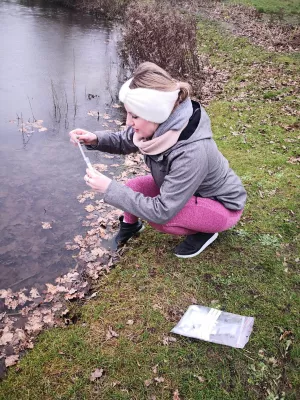
Karolina Brylka
Doctoral student

Rethinking the chronology of early Paleogene sediments in the western North Atlantic using diatom biostratigraphy
Author
Summary, in English
Ocean Drilling Program (ODP) Site 1051 (Blake Nose, western North Atlantic) is of crucial importance for reconstructing diatom evolution and biosiliceous sedimentation patterns through the early Cenozoic period of extreme greenhouse warmth followed by the progressive global cooling. The magnetostratigraphy in Hole 1051A, however, has been subject to divergent interpretations resulting in multi-million-year age control uncertainties, especially for events surrounding the early to middle Eocene transition. To resolve these uncertainties, we compare the stratigraphy of Hole 1051A to the neighboring Holes 1050A, C. We compile the published biomagnetostratigraphic data for both sites and identify three possible magnetostratigraphic solutions for Hole 1051A, the difference being the number of hiati and their duration. In order to identify the most plausible magnetostratigraphic solution for Hole 1051A, we employ the graphic correlation method, in which we compare the depth of individual magnetic reversals in both study sites against an independent proxy, i.e., 49 diatom evolutionary events identified in Holes 1050A,C and 1051A. The distribution of diatom bioevents lends strong support to the presence of two major hiati in both study sites: the upper hiatus juxtaposes magnetozone C21n on C22n, and the lower hiatus juxtaposes magnetozone C23n on C24n, eliminating the record of the initial part of the Early Eocene Climatic Optimum. Diatom, calcareous nannofossil and foraminiferal biostratigraphic markers also indicate that Hole 1051A terminated within magnetozone C28n rather than C27n. This age interpretation is strongly supported by the alignment of high-resolution weight percent biogenic SiO2 records from both study sites. The revised age models developed here for Holes 1050A,C and 1051A have profound consequences for interpretations of western North Atlantic paleoceanographic and paleoclimatic history through the early Paleogene. We propose a revised labelling of the early Eocene carbon cycle perturbations identified to date in Hole 1051A, and show how published Blake Nose δ30Si records change when data from Sites 1050 and 1051 are rescaled to the age models proposed herein. We emphasize that these refinements to the stratigraphy of Sites 1050 and 1051 are based on a study of diatom bioevents, which are here identified and calibrated to the Geomagnetic Polarity Timescale. This successful application of diatom biostratigraphy is a substantial advance toward their future utility in providing high-resolution age control for Paleogene deep-sea sites.
Department/s
- Lithosphere and Biosphere Science
- Quaternary Sciences
Publishing year
2020-06
Language
English
Publication/Series
Marine Geology
Volume
424
Document type
Journal article
Publisher
Elsevier
Topic
- Geology
Status
Published
ISBN/ISSN/Other
- ISSN: 0025-3227

